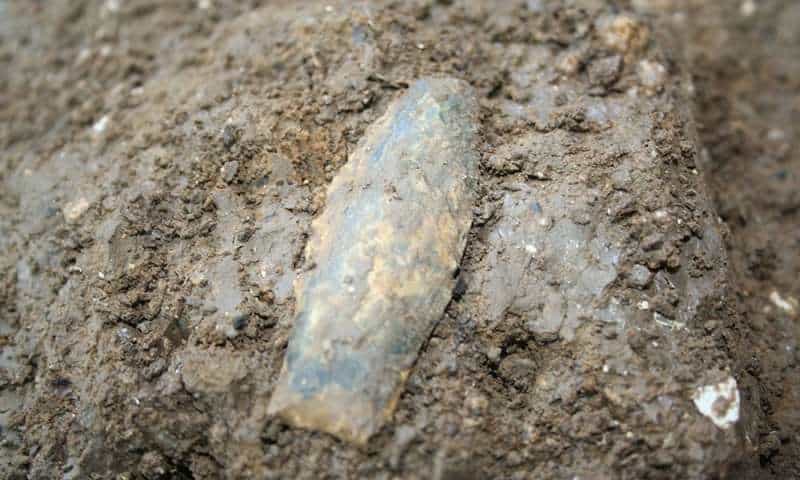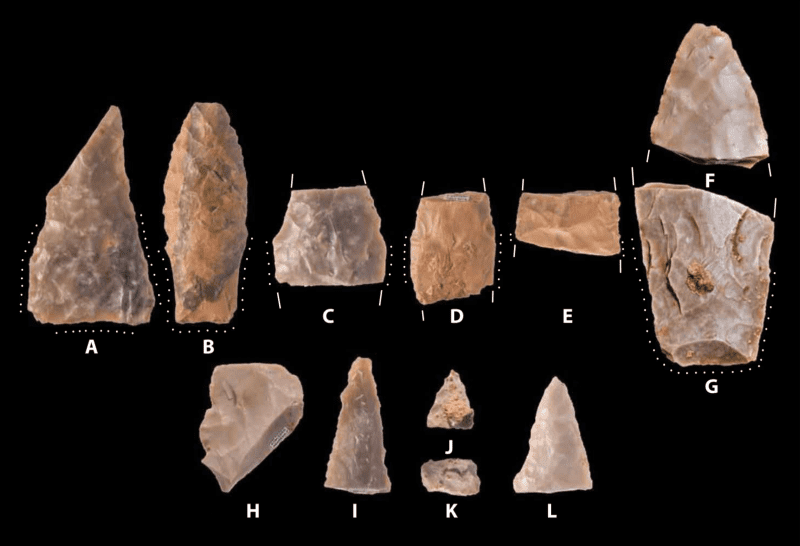While digging at a site in Central Texas, archaeologists have come across a stockpile of ancient weapons. Dating of the sediment from which the spears and other tools were unearthed suggests the artifacts are 15,500 years old. That’s much older than artifacts found at Clovis sites, long believed to be the first culture that colonized the Americas.
Different shape, different timeline
The projectile points found at the Debra L. Friedkin site in Texas are made of chert. What’s immediately apparent is that their shape is very distinct from the Clovis-style lanceolate (leaf-shaped) fluted projectile point with concave bases. Instead, the newly-identified technology features triangular projectiles.
“There is no doubt these weapons were used for hunting game in the area at that time,” said Michael Waters, professor of anthropology at Texas A&M and lead author of the new study, said in a statement. “The discovery is significant because almost all pre-Clovis sites have stone tools, but spear points have yet to be found. These points were found under a layer with Clovis and Folsom projectile points. Clovis is dated to 13,000 to 12,700 years ago and Folsom after that. The dream has always been to find diagnostic artifacts – such as projectile points – that can be recognized as older than Clovis and this is what we have at the Friedkin site.”
Water and colleagues uncovered a staggering trove of 100,000 artifacts, including 328 tools and 12 complete and fragmented projectile points. Using optically stimulated luminescence on sediments — a dating method that measures the amount of light emitted from energy stored in certain rock types and derived soils — they determined the artifacts were between 13,500 and 15,500 years old.
It’s possible that the weapons were fashioned by people belonging to an earlier, separate migration into the Americas. The earliest artifacts belonging to the Clovis culture, a prehistoric Paleo-Indian culture, are dated to about 13,000 years ago — this evidence was previously thought to reflect the earliest occupation of the Americas. It is thought that the Clovis arrived in North America via an ice-free corridor through glacier-covered Alaska and western Canada.
Clovis points are found in association with the bones of Ice Age animals in sites in many areas of North America and document both the importance of big game hunting and the effectiveness of early Palaeo weaponry. The species exploited included mammoths, who grazed on the tundra grasses and mastodons who browsed on the spruce needles. Giant, long-horned bison provided a secondary food source.
There’s another distinct style of spear point technology, the Western Stemmed Tradition, whose points were leaf-shaped like Clovis, but which were tapered at the base instead of being fluted. The oldest Western Stemmed Tradition artifacts are dated to close to the earliest ones of the Clovis variety, circa 13,000 years ago. Some archaeologists argue that Western Stemmed Tradition precedes Clovis.

Excavations at the Debra L. Friedkin site 2016. Credit: Center for the Study of the First Americans, Texas A&M University.
Scientists have always wondered if there was any connection between Clovis and Western Stemmed Tradition cultures. The new study certainly complicates things, suggesting that the technology found at Friedkin was a precursor. Alternatively, Clovis and Western Stemmed Tradition may have appeared from a second wave of migration that brought with it the leaf-shaped points.
More excavations and alternative dating methods of Friedkin artifacts might shed more light on the matter.
“The findings expand our understanding of the earliest people to explore and settle North America,” Waters said. “The peopling of the Americas during the end of the last Ice Age was a complex process and this complexity is seen in their genetic record. Now we are starting to see this complexity mirrored in the archaeological record.”
Scientific reference: Michael R. Waters et al. Pre-Clovis projectile points at the Debra L. Friedkin site, Texas—Implications for the Late Pleistocene peopling of the Americas, Science Advances (2018).











